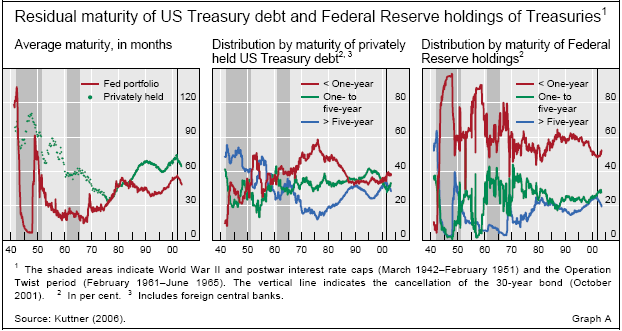Operation Twist revisited
(Extract from page 45 of BIS Quarterly Review, June 2009)
In the early 1960s, the US economy was thought to need elevated short-term rates to defend the US dollar and lower bond yields to encourage investment. The Federal Reserve engaged in Operation Twist, departing from the earlier bills-only policy to buy Treasury bonds and to sell Treasury bills.
This policy experiment is often thought to have been a failure. In fact, the experiment never happened. The Treasury's extension of maturities overwhelmed the Federal Reserve sale of bills and purchase of bonds (Graph A). "In the four years 1961-64, net purchases outside the 1-year area amounted to only $6.9 billion, of which only $2.3 billion represented over-5-year maturities. For every dollar of intermediate- and long-term bonds purchased by the System, the Treasury has sold many times that amount" (Beard (1965, p 59)). Moreover, the way that the Federal Reserve bought bonds minimised any impact on rates: "Typically, the Manager did not solicit offerings from dealers, but only purchased some of the intermediate- and long-term securities offered at the dealers' initiative" (ibid, p 60).
As described by Roosa (1963), the Treasury's strategy was to boost issuance of Treasury bills in which central banks then invested their US dollars. At the same time, advance refundings of coupon securities approaching maturity reduced outstanding debt in the "belly" of the curve, ie in the one- to five-year maturities. In current parlance, the Treasury was issuing in "barbell" fashion - at three months and beyond five years. It is not clear that studies that related a 10-year Treasury bond yield to a three-month bill rate took proper account of the Treasury strategy.

